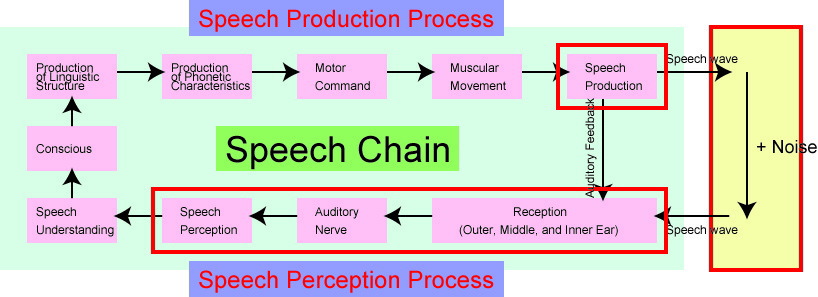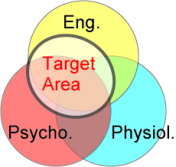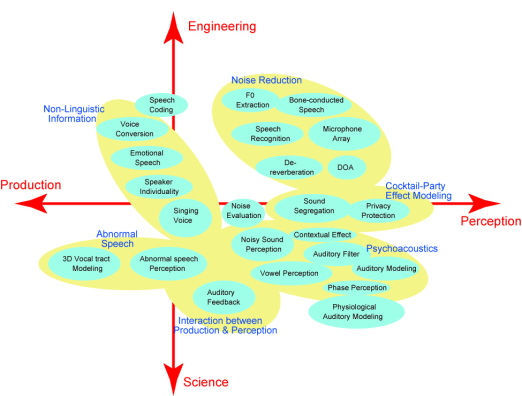|
|
| RESEARCH TOPICS (01/Jul/2017) |
 Interests Interests
Interests of Akagi Lab. are speech signal processing and modeling the speech
perception mechanism of human beings. Speech is the most natural means
of communication between human beings. Therefore, it is believed that modeling
these mechanisms is able to realize high-performance speech processing
systems.
 Research Areas Research Areas
Fig. 1 shows the principle procedures of speech communication (production
and perception). Akagi laboratory .is mainly focusing on the topics indicated
by the red blocks, such as speech production, speech communication in real
environments, and speech perception. In our research, not only engineering
(digital signal processing) but also knowledge of physiology and/or psychology
is required as shown in Fig. 2.

Fig. 1 Principle of speech communication

Fig. 2 Related research fields
 Research Issues Research Issues
In Figure 3;
Production: Through modeling the speech production mechanisms, the research
is aimed to synthesize the natural speech. The research includes: to investigate
the relationship between speech spectrum and shape of vocal tract, to synthesize
natural speech with non-linguistic information (e.g., individuality and
emotion), to synthesize singing voice.
Perception: Through modeling the perception mechanisms of human beings,
the research is aimed to recognize speech in real-world conditions. Specifically,
the research includes: to realize cock-tail-party effect, to enhance speech.

Fig. 3 View of research topics
1. Non-linguistic Information 
1-1 Singing Voice
1-2 Speaker Indivisuality
1-3 Emotional Speech
1-4 Voice Conversion
1-5 Speech Coding
2. Speech recovery 
2-1 Noise Reduction
2-2 F0 Extraction
2-3 De-reverberation
2-4 Bone-conducted Speech
2-5 Speech Recognition
2-6 DOA
3. Cocktail-party Effect Modeling 
3-1 Sound Segregation
3-2 Privacy Protection
3-3 Noisy Sound Perception
4. Psychoacoustics 
4-1 Auditory Model
4-2 Contextual Effect
4-3 Auditory Filter
4-4 Phase Perception
4-5 Speech Perception
4-6 Noise Evaluation
4-7 Pitch Perception
4-8 Direction Perception
5. Physiological Auditory Modeling 
6. Abnormal Speech 
6-1 Abnormal Speech Perception
6-2 3D Vocal Tract Modeling
7. Interaction between Perception and Production 
8. Signal Analysis 
|
|
|